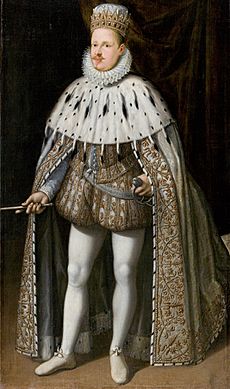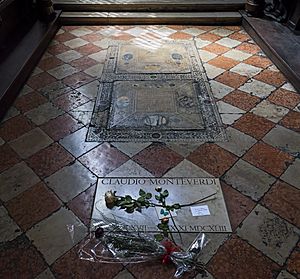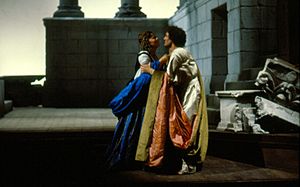Claudio Monteverdi facts for kids
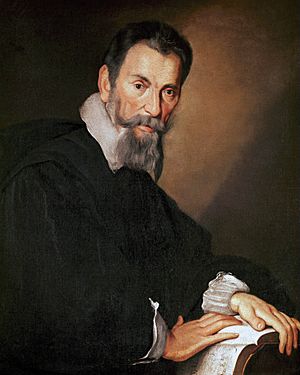
Claudio Giovanni Antonio Monteverdi (baptized 15 May 1567 – 29 November 1643) was a famous Italian composer. He was also a choirmaster and played string instruments. Monteverdi wrote both non-religious and religious music. He was a pioneer in creating opera, which is a play set to music.
Many people see him as a key figure who helped music change. He lived during the time when Renaissance music was ending and Baroque music was beginning.
Monteverdi was born in Cremona, Italy. There, he started his music studies and wrote his first pieces. He then worked for the Duke of Mantua from about 1590 to 1613. After that, he moved to the Republic of Venice. He became the music director (called maestro di cappella) at the famous San Marco church. He stayed there until he died.
Many of Monteverdi's works, especially his stage shows, have been lost over time. But we still have nine books of his madrigals (songs for several voices). He also wrote large religious pieces, like his Vespro della Beata Vergine (Vespers for the Blessed Virgin) from 1610. We also have three complete operas by him.
His opera L'Orfeo (1607) is the oldest opera that is still performed often today. Later in his life, he wrote more operas for Venice. These include Il ritorno d'Ulisse in patria and L'incoronazione di Poppea.
Monteverdi used older music styles, like polyphony (many voices singing different melodies). But he also made big changes in how music was structured and how melodies were written. He started using a new technique called basso continuo. This was a special way of writing music that became very important in the Baroque period.
Sometimes, his new ideas caused arguments. He called his modern style the seconda pratica (second practice). He said it was different from the older, more traditional style, which he called the prima pratica (first practice). For a long time, people forgot about his music. But in the early 1900s, his works were rediscovered. Today, he is known as a very important composer in European music history. His music is often performed and recorded.
Template:TOC limit=3
Contents
Monteverdi's Life Story
His Early Life in Cremona
Monteverdi was baptized in a church in Cremona on May 15, 1567. His full name was Claudio Zuan Antonio. He was the first child of Baldassare Monteverdi, who was an apothecary (like a pharmacist). Claudio's brother, Giulio Cesare Monteverdi, also became a musician.
We don't know much about Monteverdi's early music lessons. His first published work was a collection of motets (short religious songs) in 1582. He was only 15 years old. In these early works, he said he was a student of Marc'Antonio Ingegneri. Ingegneri was the music director at Cremona Cathedral. Experts believe Ingegneri taught Monteverdi a lot about music composition. Monteverdi also learned to play instruments like the viol and to sing.
Even when he was young, Monteverdi had connections outside Cremona. His first non-religious works were books of madrigals. These were popular songs for five voices. His first book of madrigals (1587) was dedicated to a Count in Verona. His second book (1590) was for a leader in Milan. This shows he was already making a name for himself.
Working for the Duke of Mantua
Around 1590 or 1591, Monteverdi started working for Duke Vincenzo I Gonzaga in Mantua. He played the vivuola, which was a string instrument. He also wanted to become a well-known composer.
Duke Vincenzo wanted his court to be a center for music. He hired many talented musicians. Monteverdi married Claudia de Cattaneis, a court singer, in 1599. They had three children. Monteverdi's brother, Giulio Cesare, also joined the court musicians in 1602.
Monteverdi was highly respected by the Duke. He traveled with the Duke on military trips and to other countries. In 1601, Monteverdi became the chief music director (maestro di capella) for the Duke.
Opera and Challenges
In 1606, the Duke's son, Francesco, asked Monteverdi to write an opera. This opera was L'Orfeo, and it was performed in 1607. It was a big success. In 1608, Monteverdi wrote another opera, L'Arianna. Sadly, almost all the music for L'Arianna is lost, except for a very famous part called Ariadne's Lament.
Monteverdi worked very hard on these pieces. But he also faced sad personal events. His wife died in 1607, and a young singer who was supposed to star in Arianna died in 1608. Monteverdi was also unhappy with how little the Duke paid him. He tried to leave his job.
Even though the Duke increased his pay, Monteverdi started looking for work elsewhere. He published his Vespers in 1610. He dedicated this work to Pope Paul V. He also visited Rome and Venice, perhaps hoping to find a new job.
Duke Vincenzo died in 1612. His son Francesco took over and fired Monteverdi and his brother. They returned to Cremona with very little money. In 1613, Monteverdi applied for the top music job at St Mark's Basilica in Venice. He got the job in August 1613.
Life in Venice
Leading Music in Venice
When Monteverdi arrived in Venice, the music program at San Marco was in bad shape. His main job was to hire, train, and manage the musicians. There were about 30 singers and six instrumentalists. He also wanted to bring in new, modern music styles, including the use of basso continuo.
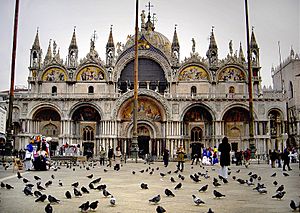
Monteverdi was expected to compose music for all the church's important events. This included a new Mass every year. He also wrote music for other churches and for state banquets. The leaders of San Marco were very happy with his work. In 1616, they raised his salary.
Monteverdi felt much more free in Venice than he had in Mantua. He even turned down offers to return to Mantua. He still took on some projects for the Duke of Mantua, but many of these were delayed or lost.
He also received requests for music from other Italian cities. For example, he wrote music for the Milanese community in Venice and a Requiem Mass for the Florentine community. He also wrote a dramatic show called Il combattimento di Tancredi e Clorinda for a nobleman's home in 1624. This piece was based on a famous poem.
Monteverdi's music leadership was noticed by visitors from other countries. A Dutch diplomat wrote that he heard "the most perfect music" directed by Monteverdi. Monteverdi also wrote music for the Crown Prince of Poland when he visited Venice.
Later Years and Priesthood
Around 1630, Monteverdi faced more difficult times. Mantua was invaded and suffered from the plague. The plague then spread to Venice, causing many deaths. Monteverdi's assistant and his younger brother likely died from the plague.
By this time, Monteverdi was in his sixties, and he composed less. He wrote a Mass to celebrate Venice being saved from the plague in 1631. In 1632, he became a priest. This might mean he thought about retiring to Cremona.
His Final Operas
In 1637, the first public opera house in Europe opened in Venice. This brought new energy to the city's music scene. Monteverdi started composing more actively again. In 1638, his eighth book of madrigals was published.
Monteverdi wrote three new operas for the public stage. These were Il ritorno d'Ulisse in patria (The Return of Ulysses to his Homeland, 1640), Le nozze d'Enea e Lavinia (The Marriage of Aeneas and Lavinia, 1641, now lost), and L'incoronazione di Poppea (The Coronation of Poppea, 1643). People at the time praised Monteverdi for bringing back theatrical music. They believed his music would last forever.
Monteverdi died in Venice on November 29, 1643. He was buried in the Church of the Frari.
Monteverdi's Amazing Music
From Renaissance to Baroque
Music historians agree that Monteverdi lived during a time of great change in music. He is seen as a bridge between the Renaissance and Baroque periods.
In the Renaissance, music was often seen as a formal science. But in the Baroque era, music became more about expressing feelings. It was used more to make religious events, social gatherings, and celebrations more exciting. Solo singing with instruments (called monody) became very important. This new style replaced the older style of many voices singing together (polyphony). Monteverdi was a key part of this change.
His Early Madrigals
Monteverdi's first teacher, Ingegneri, was good at a vocal style called musica reservata. This style used special notes and sounds to paint pictures with words. Monteverdi's early works used this style. He also studied other modern composers. He learned how to express strong feelings in music.
His first published works in 1582–83 showed he was a talented student. They showed he understood the music style of his time. His Canzonette collection from 1584 was even better. These short songs for three voices were light and modern.
His first book of madrigals (1587) showed a playful, country style. His second book (1590) included a masterpiece called "Ecco mormorar l'onde." This piece was strongly influenced by another composer named Giaches de Wert.
Monteverdi often used a technique called imitatio. This meant he used ideas from other composers as models for his own music. He did this throughout his career.
Madrigals: Books 3, 4, and 5
Monteverdi's time in Mantua saw the publication of his third (1592), fourth (1603), and fifth (1605) books of madrigals. The third book showed the strong influence of Wert, his boss in Mantua. Monteverdi used a modern and expressive style. He set poems by famous writers like Torquato Tasso and Giovanni Battista Guarini.
As the 1590s went on, Monteverdi moved closer to his new style, the seconda pratica. He used dissonance (notes that sound clashing) in new and daring ways. He put the poet's words first, even if it meant breaking some music rules.
The fourth book of madrigals included pieces that some people called "modern." The fifth book looked more to the future. For example, Monteverdi used the concertato style with basso continuo. This was a new feature of the Baroque era. He used complex counterpoint and bold harmonies.
Famous Operas: L'Orfeo and L'Arianna
L'Orfeo
L'Orfeo (1607) starts with a short trumpet fanfare. A character representing music sings a prologue. The music often repeats a special tune, showing the "power of music." This is one of the first examples of a leitmotif in opera (a musical theme for a character or idea).
The first act is happy and peaceful. But in the second act, when the news of Euridice's death arrives, the music becomes sad and clashing. In Act 3, Orfeo sings a powerful song to convince Caronte to let him enter the underworld. Monteverdi used amazing vocal effects in this part.
In Act 4, Proserpina sings beautifully for Orfeo. The last act is short and ends with a lively dance. Throughout the opera, Monteverdi used polyphony in new ways. He mixed the old madrigal style with the new monodic style, where the words were most important.
L'Arianna
Most of the music for L'Arianna (1608) is lost. But we still have Ariadne's Lament. This piece was so popular that Monteverdi published it separately. In the opera, the lament shows Arianna's many feelings after being left alone: sadness, anger, fear, and hopelessness.
Music experts say Monteverdi created the "lament" as a new type of vocal music. It became a standard scene in 17th-century operas. The opening words, "Lasciatemi morire" (Let me die), are sung with a clashing chord that sounds like "an unforgettable stab of pain." This lament shows Monteverdi's amazing new ideas in music.
The Vespers: Sacred Music
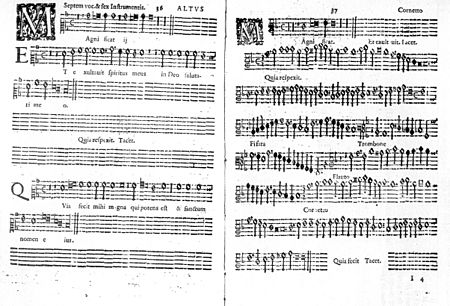
The Vespro della Beata Vergine (Vespers for the Blessed Virgin), published in 1610, was Monteverdi's first major religious work in a long time. It has 14 parts, including psalms, "sacred concertos," and two settings of the Magnificat. These pieces together make up a Vespers service for a feast day of the Virgin Mary.
Monteverdi used many different music styles in this work. He mixed older styles, like cantus firmus (a fixed melody), with his newest madrigal styles. Some parts sound like his opera L'Orfeo.
The "sacred concertos" are like short musical pieces that divide the psalms. Monteverdi used modern rhythms, changing speeds often. He carefully combined words and music. Experts say Monteverdi's mix of different elements makes this music unique.
Madrigals: Books 6, 7, and 8
Monteverdi published his sixth (1614), seventh (1619), and eighth (1638) books of madrigals while in Venice. The sixth book contains older works from his time in Mantua. It shows his last pieces in the old style, mixed with his new expressive style. The main theme of this book is loss. The most famous piece is the five-voice version of Lamento d'Arianna.
The seventh book moved away from the traditional madrigal. It focused on duets for two voices. It also included larger pieces for groups of musicians. This book showed Monteverdi's love for dramatic and emotional poetry.
The eighth book, called Madrigals of War and Love, is divided into two parts. One part is about "war" and the other about "love." The "war" section includes pieces honoring the Holy Roman Emperor. Many of Monteverdi's favorite poets are featured.
The Combattimento di Tancredi e Clorinda (1624) is a central piece in the "war" section. Monteverdi said this piece used his stile concitato (excited style). This style was meant to sound like a brave person in battle. It was one of the first pieces to use pizzicato (plucking strings) and sounds like fanfares.
Critics say the eighth book is a statement of Monteverdi's artistic ideas. He changed and expanded the madrigal form to fit his vision. The pieces in this book show how much music could express in the early 17th century.
Late Operas and Final Works
In his last years, Monteverdi focused a lot on opera for the public theaters in Venice. He helped change opera from a private show for rich people to a major public entertainment. His two surviving operas from this time, Il ritorno d'Ulisse in patria and L'incoronazione di Poppea, are considered the first "modern" operas.
Il ritorno (1640) shows influences from his earlier works. Penelope's lament is like Arianna's lament. The battle scenes use the stile concitato. In L'incoronazione (1643), Monteverdi used specific musical ideas to show different moods and situations. For example, fast rhythms showed love, and clashing notes showed conflict.
The Selva morale e spirituale (1641) and the Messa et salmi (published after his death in 1650) are collections of the religious music Monteverdi wrote for San Marco. The Selva morale starts with songs about life's short nature. It also includes a Mass that might have been written to celebrate the end of the 1631 plague.
Monteverdi's Legacy Today
During his lifetime, Monteverdi was very famous. His funeral was grand, like a royal event. But after the 1650s, his music was mostly forgotten. Only his Lamento d'Arianna remained popular for a while.
Interest in Monteverdi began to grow again in the late 1700s and early 1800s. But he was still seen mostly as a historical curiosity. Real interest in his music started in 1881 when a shorter version of L'Orfeo was published. Then, manuscripts of L'incoronazione (1888) and Il ritorno (1904) were found.
By the early 1900s, all three of his operas were performed again. The Italian writer Gabriele D'Annunzio called Monteverdi "the divine Claudio." He saw Monteverdi as the true founder of Italian music.
After World War II, Monteverdi's operas began to be performed in major opera houses. They are now a regular part of the opera world. His religious music took longer to become popular again. The 1610 Vespers were not published in a modern edition until 1932.
Today, there is a lot of interest in performing Monteverdi's music using historical instruments, just as it would have sounded in his time. His surviving operas are performed regularly around the world. Experts call Monteverdi "the most important composer in late Renaissance and early Baroque Italy." He is also known as the first great opera composer.
Modern composers are often drawn to Monteverdi because he was seen as a "Modern," someone who broke the rules. But he was also practical, using whatever musical ideas worked best. He was able to use new techniques while still respecting older styles. Monteverdi's greatest achievement was his ability to show human emotions in music, both for the stage and for smaller performances.
Images for kids
See also
 In Spanish: Claudio Monteverdi para niños
In Spanish: Claudio Monteverdi para niños



